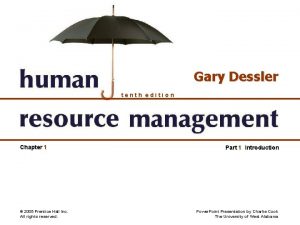Human Resource Management 1 ELEVENTH EDITION GARY DESSLER
























- Slides: 24

Human Resource Management 1 ELEVENTH EDITION GARY DESSLER Part 5 | Employee Relations Chapter 14 Ethics, Justice, and Fair Treatment in HR Management Power. Point Presentation by Charlie Cook The University of West Alabama

Ethics and Fair Treatment at Work • The Meaning of Ethics Ø The principles of conduct governing an individual or a group. Ø The standards you use to decide what your conduct should be. Ø Ethical behavior depends on a person’s frame of reference. • Ethical Decisions Ø Normative judgments- Good bad, right wrong, better or worse. Ø Morality- Society’s accepted standard of behavior. © 2008 Prentice Hall, Inc. All rights reserved. 2

FIGURE 14– 1 The Wall Street Journal Workplace. Ethics Quiz Note: The spread of technology into the workplace has raised a variety of new ethical questions, and many old ones still linger. Source: Wall Street Journal, October 21, 1999, pp. B 1–B 4. Reproduced with permission via Copyright Clearance Center. © 2008 Prentice Hall, Inc. All rights reserved. 3

TABLE 14– 1 Specific Observed Unethical Behaviors Abusive or intimidating behavior toward employees 21% Lying to employees, customers, vendors, or to the public 19% A situation that places employee interests over organizational interests 18% Violations of safety regulations 16% Misreporting of actual time worked 16% E-mail and Internet abuse 13% Discrimination on the basis of race, color, gender, age, or similar categories 12% Stealing or theft 11% Sexual harassment 9% Provision of goods or services that fail to meet specifications 8% Misuse of confidential information 7% Alteration of documents 6% Falsification or misrepresentation of financial records or reports 5% Improper use of competitors’ inside information 4% Price fixing 3% Giving or accepting bribes, kickbacks, or inappropriate gifts 3% Source: From 2005 National Business Ethics Survey: How Employees Perceive Ethics at Work, 2005, p. 25. Copyright © 2006, Ethics Resource Center (ERC). Used with permission of the ERC, 1747 Pennsylvania Ave. , N. W. , Suite 400, Washington, DC 2006, www. ethics. org. Reprinted in O. C. Ferrell, John Fraedrich, and Linog Ferrell, Business Ethics (Boston: Houghton Mifflin, 2008) , p. 61. © 2008 Prentice Hall, Inc. All rights reserved. 4

Ethics and Fair Treatment at Work (cont’d) A behavior may be legal but unethical. Ethics and the Law A behavior may be illegal but ethical. A behavior may be both legal and ethical. A behavior may be both illegal and unethical. © 2008 Prentice Hall, Inc. All rights reserved. 5

Ethics, Fair Treatment, and Justice Components of Organizational Justice Distributive Justice © 2008 Prentice Hall, Inc. All rights reserved. Procedural Justice Interactional (Interpersonal) Justice 6

JUSTICE: Fairness – Results – Assumed or implied balance of fairness and equality Commutative Justice – Attempting to give all parties equal treatment without unique differences being considered. Distributive Justice – Allocation of justice that takes into consideration individual differences Example: ADA – American’s with Disabilities Act – passed in 1990 © 2008 Prentice Hall, Inc. All rights reserved. 7

FIGURE 14– 2 Perceptions of Fair Interpersonal Treatment Scale Source: Michelle A. Donovan et al. , “The Perceptions of Their Interpersonal Treatment Scale: Development and Validation of a Measure of Interpersonal Treatment in the Workplace, ” Journal of Applied Psychology, 83, no. 5 (1998), p. 692. © 2008 Prentice Hall, Inc. All rights reserved. 8

What Shapes Ethical Behavior at Work? Individual Factors The Organization’s Culture Ethical Policies and Codes © 2008 Prentice Hall, Inc. All rights reserved. Ethical Behavior At Work Organizational Factors The Boss’s Influence 9

FIGURE 14– 3 How Do My Ethics Rate? Source: Adapted from A. Reichel and Y. Neumann, Journal of Instructional Psychology, March 1988, pp. 25– 53. With permission of the authors. © 2008 Prentice Hall, Inc. All rights reserved. 10

TABLE 14– 2 Principal Causes of Ethical Compromises Senior Mgmt. Middle Mgmt. Front. Line Supv. Prof. Non. Mgmt. Admin. Salaried Hourly Meeting schedule pressure 1 1 1 Meeting overly aggressive financial or business objectives 3 2 2 2 Helping the company survive 2 3 4 4 3 4 Advancing the career interests of my boss 5 4 3 3 4 5 Feeling peer pressure 7 7 5 6 5 3 Resisting competitive threats 4 5 6 7 Saving jobs 9 6 7 7 7 6 Advancing my own career or financial interests 8 9 9 8 Other 6 8 8 9 Note: 1 is high, 9 is low. Sources: O. C. Ferrell and John Fraedrich, Business Ethics, 3 rd ed. (New York: Houghton Mifflin, 1997), p. 28; adapted from Rebecca Goodell, Ethics in American Business: Policies, Programs, and Perceptions (1994), p. 54. Permission provided courtesy of the Ethics Resource Center, 1120 6 th Street NW, Washington, DC: 20005. © 2008 Prentice Hall, Inc. All rights reserved. 11

Employees and Ethical Dilemmas • Questions employees should ask when faced with ethical dilemmas: Ø Is the action legal? Ø Is it right? Ø Who will be affected? Ø Does it fit the company’s values? Ø How will it “feel” afterwards? Ø How will it look in the newspaper? Ø Will it reflect poorly on the company? © 2008 Prentice Hall, Inc. All rights reserved. 12

What Is Organizational Culture? • Organizational culture Ø The characteristic values, traditions, and behaviors a company’s employees share. • How is culture is revealed? Ø Ceremonial events Ø Written rules and spoken commands Ø Office layout Ø Organizational structure Ø Dress codes Ø Cultural symbols and behaviors Ø Figureheads © 2008 Prentice Hall, Inc. All rights reserved. 13

Human Resource Management’s Role in Promoting Ethics and Fair Treatment Ethics Training Selection Performance Appraisal Workplace Aggression and Violence © 2008 Prentice Hall, Inc. All rights reserved. HRM–Related Ethics Activities Reward and Disciplinary Systems HR’s Ethics and Compliance Activities 14

FIGURE 14– 4 U. S. Data Trust Web site Source: Reprinted with permission of U. S. Data Trust Corporation. www. USData. Trust. com/company. © 2008 Prentice Hall, Inc. All rights reserved. 15

Employee Discipline and Privacy Fair and Just Discipline Process Clear Rules and Regulations © 2008 Prentice Hall, Inc. All rights reserved. A System of Progressive Penalties An Appeals Process 16

Restrictions on Workplace Monitoring • The Electronic Communications Privacy Act (ECPA) Ø Restricts employer interception and monitoring of oral and wire communications. v “business v “consent purpose exception” • Common law Ø Provides protections against invasion of privacy. © 2008 Prentice Hall, Inc. All rights reserved. 17

FIGURE 14– 8 Sample Telephone Monitoring Acknowledgement Statement Source: Reprinted with permission from Bulletin to Management (BNA Policy and Practice Series) 48, no. 14, Part II, (April 3, 1997), p. 7. © 1997 by The Bureau of National Affairs, Inc. © 2008 Prentice Hall, Inc. All rights reserved. 18

The Plant Closing Law • WARNA - Worker Adjustment and Retraining Notification Act (1989) Ø Requires employers of 100 or more employees to give 60 days notice before closing a facility or starting a layoff of 50 people or more. Ø The law does not prevent the employer from closing down, nor does it require saving jobs. Ø The law is intended to give employees time to seek other work or retraining by giving them advance notice of the shutdown. © 2008 Prentice Hall, Inc. All rights reserved. 19

Layoffs and Downsizing • Bumping/Layoff Procedures Ø Seniority is usually the determinant of who will work. Ø Seniority can give way to merit or ability. Ø Seniority is usually based on the employee’s hiring date, not the date he or she took a particular job. Ø Companywide seniority allows an employee in one job to bump or displace an employee in another job. © 2008 Prentice Hall, Inc. All rights reserved. 20

Layoffs and Downsizing • Alternatives to Downsizing Ø Voluntarily reducing employees’ pay. Ø Concentrating employees’ vacations. Ø Taking voluntary time off. Ø Releasing temporary workers. Ø Offering early retirement buyout packages. © 2008 Prentice Hall, Inc. All rights reserved. 21

Adjusting to Downsizings and Mergers • Reduction in Force Guidelines Ø Identify objectives and constraints. Ø Form a downsizing team. Ø Address legal issues. Ø Plan post-reduction actions. Ø Address security concerns. © 2008 Prentice Hall, Inc. All rights reserved. 22

Adjusting to Downsizings and Mergers (cont’d) • Guidelines for treatment of departing employees during a merger: Ø Avoid the appearance of power and domination. Ø Avoid win–lose behavior. Ø Remain businesslike and professional. Ø Maintain a positive feeling about the acquired company. Ø Remember that how the organization treats the acquired group will affect those who remain. © 2008 Prentice Hall, Inc. All rights reserved. 23

KEY TERMS ethics code distributive justice procedural justice interactional (interpersonal) justice organizational culture nonpunitive discipline Electronic Communications Privacy Act (ECPA) dismissal © 2008 Prentice Hall, Inc. All rights reserved. wrongful discharge unsatisfactory performance misconduct insubordination termination interview outplacement counseling exit interviews bumping/layoff procedures downsizing 24
 Line and staff aspects of hrm
Line and staff aspects of hrm Eleventh edition management
Eleventh edition management Management 11th edition by stephen p robbins
Management 11th edition by stephen p robbins Management eleventh edition
Management eleventh edition Management eleventh edition stephen p robbins
Management eleventh edition stephen p robbins Hrm by gary dessler
Hrm by gary dessler Gary dessler
Gary dessler Roi metrics
Roi metrics Management fifteenth edition
Management fifteenth edition International human resource management dowling 6th edition
International human resource management dowling 6th edition Performance appraisal in human resource management
Performance appraisal in human resource management The trends shaping human resource management
The trends shaping human resource management Time management human resources
Time management human resources Types of retail organization structure
Types of retail organization structure Management vs human resource management
Management vs human resource management Eleventh 5 year plan
Eleventh 5 year plan Eleventh 5 year plan
Eleventh 5 year plan Eleventh plan
Eleventh plan For his eleventh birthday elvis presley
For his eleventh birthday elvis presley White e lippitt propõem três estilos de liderança
White e lippitt propõem três estilos de liderança Alexander fleming
Alexander fleming Dessler 2008
Dessler 2008 Dessler 2005
Dessler 2005 Resource management pmp
Resource management pmp Project human resource management pmbok
Project human resource management pmbok












































